SIU Director’s Report - Case # 17-PVI-374
Warning:
This page contains graphic content that can shock, offend and upset.
Contents:
Mandate of the SIU
The Special Investigations Unit is a civilian law enforcement agency that investigates incidents involving police officers where there has been death, serious injury or allegations of sexual assault. The Unit’s jurisdiction covers more than 50 municipal, regional and provincial police services across Ontario.
Under the Police Services Act, the Director of the SIU must determine based on the evidence gathered in an investigation whether an officer has committed a criminal offence in connection with the incident under investigation. If, after an investigation, there are reasonable grounds to believe that an offence was committed, the Director has the authority to lay a criminal charge against the officer. Alternatively, in all cases where no reasonable grounds exist, the Director does not lay criminal charges but files a report with the Attorney General communicating the results of an investigation.
Under the Police Services Act, the Director of the SIU must determine based on the evidence gathered in an investigation whether an officer has committed a criminal offence in connection with the incident under investigation. If, after an investigation, there are reasonable grounds to believe that an offence was committed, the Director has the authority to lay a criminal charge against the officer. Alternatively, in all cases where no reasonable grounds exist, the Director does not lay criminal charges but files a report with the Attorney General communicating the results of an investigation.
Information restrictions
Freedom of Information and Protection of Privacy Act (“FIPPA”)
Pursuant to section 14 of FIPPA (i.e., law enforcement), certain information may not be included in this report. This information may include, but is not limited to, the following:- Confidential investigative techniques and procedures used by law enforcement agencies; and
- Information whose release could reasonably be expected to interfere with a law enforcement matter or an investigation undertaken with a view to a law enforcement proceeding.
- Subject Officer name(s);
- Witness Officer name(s);
- Civilian Witness name(s);
- Location information;
- Witness statements and evidence gathered in the course of the investigation provided to the SIU in confidence; and
- Other identifiers which are likely to reveal personal information about individuals involved in the investigation.
Personal Health Information Protection Act, 2004 (“PHIPA”)
Pursuant to PHIPA, any information related to the personal health of identifiable individuals is not included. Other proceedings, processes, and investigations
Information may have also been excluded from this report because its release could undermine the integrity of other proceedings involving the same incident, such as criminal proceedings, coroner’s inquests, other public proceedings and/or other law enforcement investigations.Mandate engaged
The Unit’s investigative jurisdiction is limited to those incidents where there is a serious injury (including sexual assault allegations) or death in cases involving the police.
“Serious injuries” shall include those that are likely to interfere with the health or comfort of the victim and are more than merely transient or trifling in nature and will include serious injury resulting from sexual assault. “Serious Injury” shall initially be presumed when the victim is admitted to hospital, suffers a fracture to a limb, rib or vertebrae or to the skull, suffers burns to a major portion of the body or loses any portion of the body or suffers loss of vision or hearing, or alleges sexual assault. Where a prolonged delay is likely before the seriousness of the injury can be assessed, the Unit should be notified so that it can monitor the situation and decide on the extent of its involvement.
This report relates to the SIU’s investigation into a collision involving a police vehicle on December 23, 2017 wherein three persons, a 30-year-old man (Complainant #1), a 24-year-old woman (Complainant #2), and a 36-year-old woman (Complainant #3) sustained serious injuries.
“Serious injuries” shall include those that are likely to interfere with the health or comfort of the victim and are more than merely transient or trifling in nature and will include serious injury resulting from sexual assault. “Serious Injury” shall initially be presumed when the victim is admitted to hospital, suffers a fracture to a limb, rib or vertebrae or to the skull, suffers burns to a major portion of the body or loses any portion of the body or suffers loss of vision or hearing, or alleges sexual assault. Where a prolonged delay is likely before the seriousness of the injury can be assessed, the Unit should be notified so that it can monitor the situation and decide on the extent of its involvement.
This report relates to the SIU’s investigation into a collision involving a police vehicle on December 23, 2017 wherein three persons, a 30-year-old man (Complainant #1), a 24-year-old woman (Complainant #2), and a 36-year-old woman (Complainant #3) sustained serious injuries.
The Investigation
Notification of the SIU
At approximately 12:55 a.m. on December 24, 2017, the Ontario Provincial Police (OPP) notified the SIU to report an injury related to a motor vehicle collision. The OPP reported that on December 23, 2017, at about 2:51 p.m., Essex County OPP officers were investigating a motor vehicle collision on the eastbound 401 Highway at Highway 77, near mile marker 54, in Essex County.
The Subject Officer’s (SO’s) OPP cruiser was parked on the shoulder of the highway with its emergency lights flashing to protect other police and civilian vehicles. An eastbound civilian vehicle collided with the rear of the SO’s cruiser. The five occupants of the civilian vehicle were taken to the hospital for examination.
At about 8:31 p.m., the highway was re-opened. Complainant #2 was an occupant of the civilian vehicle and was transferred to a hospital in Windsor for further examination. At about 11:17 p.m., the OPP were advised that Complainant #2 had been admitted for treatment of back injuries.
The Team
Number of SIU Investigators assigned: 3 Number of SIU Forensic Investigators assigned: 0
Complainants:
Complainant #1
30-year-old male interviewed, medical records obtained and reviewed
Complainant #2
24-year-old female interviewed, medical records obtained and reviewed
Complainant #3
36-year-old female interviewed, medical records obtained and reviewed
Civilian Witnesses
CW #1 Interviewed
CW #2 Interviewed
CW #3 Interviewed
CW #4 Interviewed
CW #5 Interviewed
CW #6 Not interviewed, provided dash cam video and written statement to OPP
Witness Officers
WO #1 Interviewed, notes received and reviewed
WO #2 Interviewed, notes received and reviewed
WO #3 Interviewed, notes received and reviewed
Subject Officers
The SO Declined interview and to provide notes, as is the subject officer’s legal right
Civilian Witnesses
CW #1 Interviewed CW #2 Interviewed
CW #3 Interviewed
CW #4 Interviewed
CW #5 Interviewed
CW #6 Not interviewed, provided dash cam video and written statement to OPP
Witness Officers
WO #1 Interviewed, notes received and reviewed WO #2 Interviewed, notes received and reviewed
WO #3 Interviewed, notes received and reviewed
Subject Officers
The SO Declined interview and to provide notes, as is the subject officer’s legal rightIncident Narrative
At approximately 9:37 a.m., on December 23, 2017, Witness Officer (WO) #3 noticed a Ford F150 pick-up truck that had gone into the ditch near mile marker 54 of the 401 Highway in Essex County (near Tilbury Chatham-Kent).
At approximately 12:54 p.m., WO #3 was assisting tow truck operators attempting to remove the motor vehicle involved in the single vehicle collision by parking his marked OPP sport utility vehicle (SUV) on the right shoulder of eastbound Highway 401.
The SO responded to the scene to assist and parked his unmarked OPP Dodge Charger about 300 metres behind WO #3, on the right shoulder of Highway 401, with his emergency lighting system activated, in order to alert traffic of the collision scene and the presence of emergency vehicles. WO #3 also had his emergency lighting system activated. The 401 Highway at that location consists of three lanes of traffic in each direction.
At approximately 2:51 p.m., a Volkswagon (VW) motor vehicle driven by CW #2 struck the rear of the SO’s stationary OPP vehicle, on the paved right shoulder of the highway. The force of the impact pushed the OPP vehicle forward, with both vehicles turning partially westbound from an eastbound direction of travel, and pushing the OPP vehicle into a live lane of traffic. In addition to the driver, there were four passengers in the VW, three of whom sustained serious injuries. The SO, who was seated in his police vehicle at the time, also sustained some injuries.
Nature of Injuries / Treatment
Complainant #1
Complainant #1 was found to have thickening of the multiple jejunal bowel loops with likely mesenteric edema due to trauma from the seatbelt. He was released from hospital on December 28, 2017, with a diagnosis of bowel trauma, but the bowel had not been perforated.
Complainant #2
Complainant was admitted to the hospital and a CT scan of the chest, abdomen, and pelvis was performed; the following injuries were noted:
Complainant #2 was released from hospital on December 26, 2017.
Complainant #3
Complainant #3 was admitted to hospital for sternotomy pain. A CT scan was ordered and the following injuries were discovered:
Complainant #3 was discharged from hospital on December 25, 2017.
At approximately 12:54 p.m., WO #3 was assisting tow truck operators attempting to remove the motor vehicle involved in the single vehicle collision by parking his marked OPP sport utility vehicle (SUV) on the right shoulder of eastbound Highway 401.
The SO responded to the scene to assist and parked his unmarked OPP Dodge Charger about 300 metres behind WO #3, on the right shoulder of Highway 401, with his emergency lighting system activated, in order to alert traffic of the collision scene and the presence of emergency vehicles. WO #3 also had his emergency lighting system activated. The 401 Highway at that location consists of three lanes of traffic in each direction.
At approximately 2:51 p.m., a Volkswagon (VW) motor vehicle driven by CW #2 struck the rear of the SO’s stationary OPP vehicle, on the paved right shoulder of the highway. The force of the impact pushed the OPP vehicle forward, with both vehicles turning partially westbound from an eastbound direction of travel, and pushing the OPP vehicle into a live lane of traffic. In addition to the driver, there were four passengers in the VW, three of whom sustained serious injuries. The SO, who was seated in his police vehicle at the time, also sustained some injuries.
Nature of Injuries / Treatment
Complainant #1
Complainant #1 was found to have thickening of the multiple jejunal bowel loops with likely mesenteric edema due to trauma from the seatbelt. He was released from hospital on December 28, 2017, with a diagnosis of bowel trauma, but the bowel had not been perforated.Complainant #2
Complainant was admitted to the hospital and a CT scan of the chest, abdomen, and pelvis was performed; the following injuries were noted:- Small sternal fracture with no displacement;
- Pulmonary contusion;
- Multiple rib fractures;
- Adrenal hematoma;
- Abdominal injuries including possible splenic contusion and laceration; and
- Possible cardiac contusion.
Complainant #2 was released from hospital on December 26, 2017.
Complainant #3
Complainant #3 was admitted to hospital for sternotomy pain. A CT scan was ordered and the following injuries were discovered:- A sternal fracture with retrosternal hematoma;
- Fractures to the second, third, and fifth ribs on the left side; and
- A non-displaced L1 transverse fracture (nonsurgical).
Complainant #3 was discharged from hospital on December 25, 2017.
Evidence
The Scene
The scene was located on the 401 Highway at mile marker 54 in Essex County, approaching the Tilbury exit. The VW and the police cruiser were located on the right side of the highway; with the front end of the VW fully impacting the rear end of the cruiser. The VW was fully out of the live lanes of traffic, partially on the paved right shoulder and partially on the grassy/dirt area to the right of the paved shoulder. The police vehicle had its back end, to about midway into the vehicle, on the paved shoulder and the front end of the vehicle in the right live lane of traffic. Both vehicles came to rest facing partially westbound (into the oncoming lane of traffic) at an angle to the road.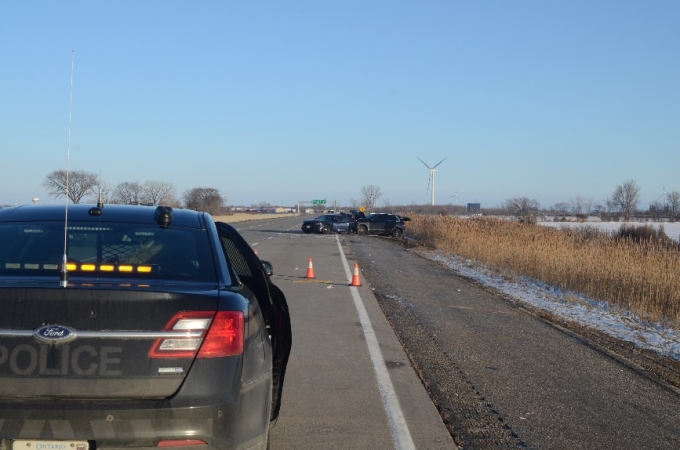
Approaching collision scene, showing VW in contact with rear of police vehicle.
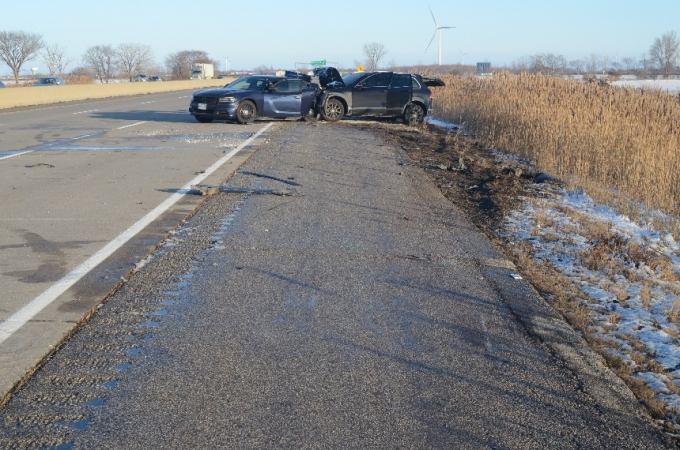
The gouge marks on the right shoulder revealing the point of impact.
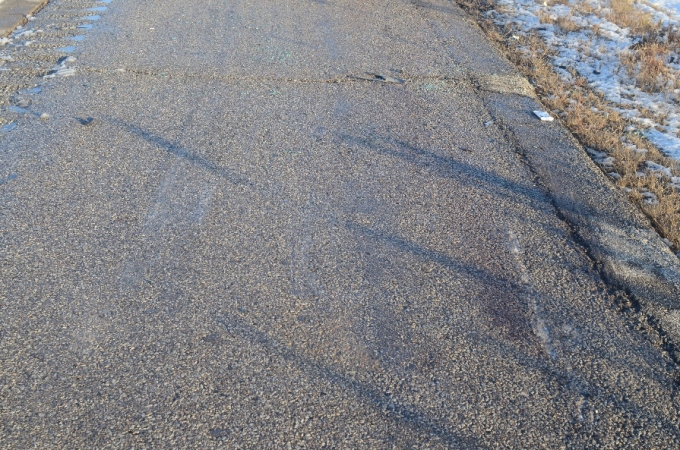
Close up of gouge marks on right shoulder.
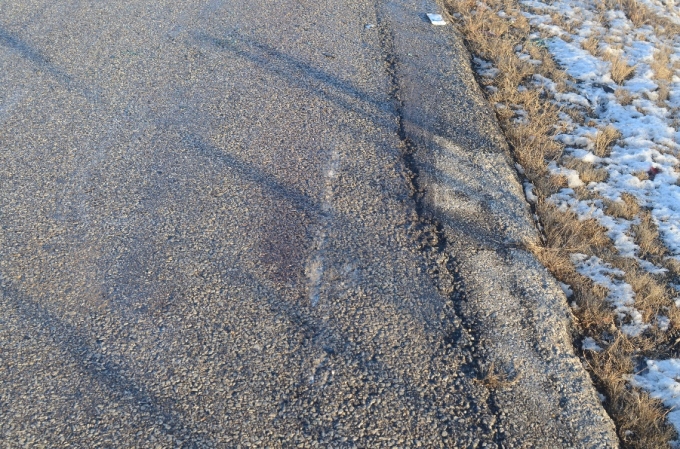
Close up of gouge marks on right shoulder.
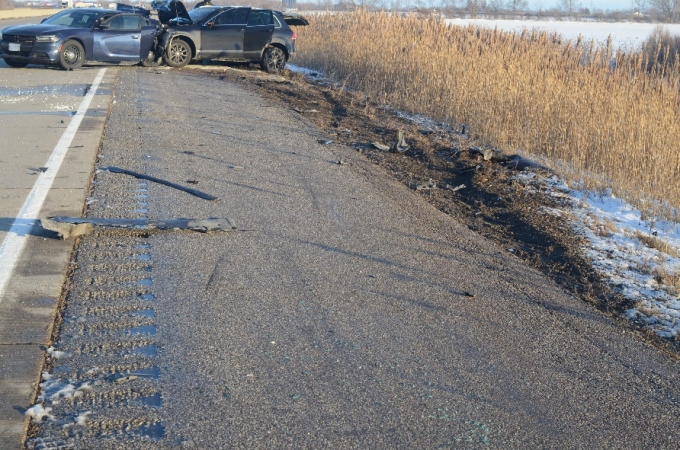
Debris and tire marks en route to stopping point of both vehicles.
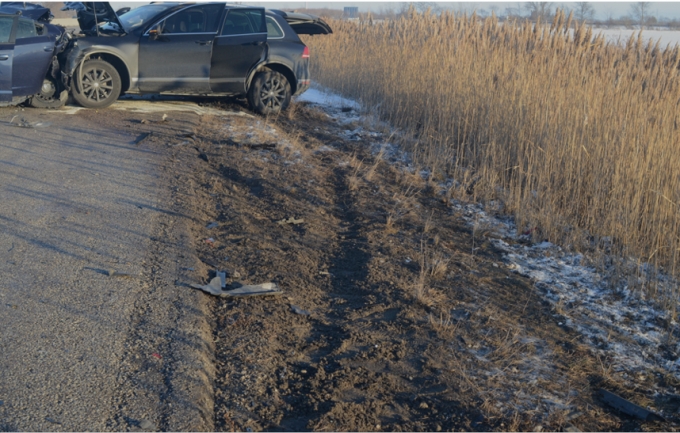
Close up of tire marks showing route of vehicles prior to coming to rest.
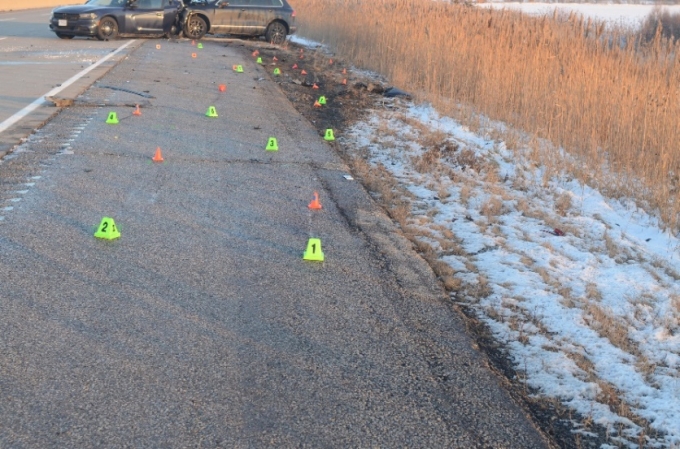
Markers following route of vehicles from point of impact to resting place.
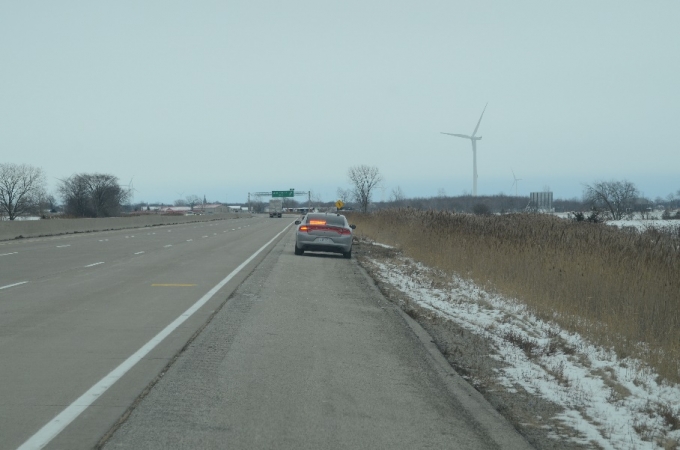
Location of police vehicle at time of impact based on reconstruction of scene from physical evidence. (Not the actual police vehicle involved in the collision).
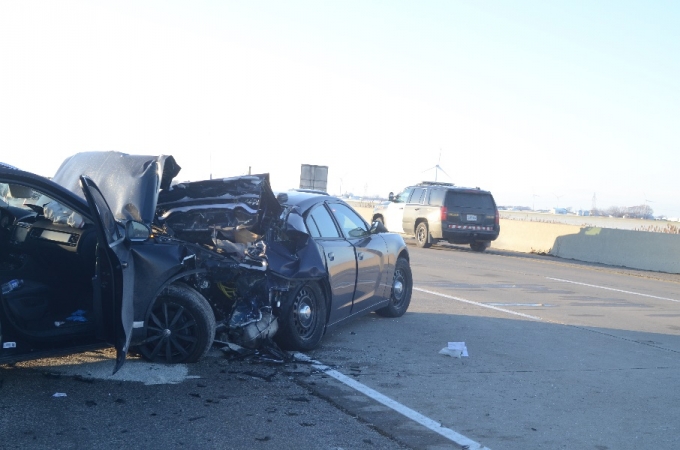
Extent of Damage.
Expert Evidence
An OPP Collision Reconstructionist, WO #2, attended the scene and prepared a report. As part of his reconstruction of the event, he took a video recording of the scene as he found it.This scene video was obtained and reviewed by the SIU and WO #2 was interviewed on January 2, 2017.
WO #2 was able to conclude that the OPP Charger had been on the right hand shoulder of Highway 401 at the time of impact. He referred to “gouging marks,” which were made when the VW collided with the OPP Charger. The video clearly showed the impact point and direction of travel as the two vehicles were carried forward post impact. The scene video confirmed that at the point of impact, the OPP Charger was on the right shoulder, and not in a live lane of traffic.
WO #2 was unable to determine if the emergency lighting on the OPP Charger was engaged at the time.
Forensic Evidence
No submissions were made to the Centre of Forensic Sciences.Video/Audio/Photographic Evidence
Dash Cam Video:
On December 23, 2017, at approximately 1:53 p.m., a motorist, CW #6, was driving eastbound on Highway 401, in Essex County, toward the Municipality of Tilbury. He passed numerous emergency vehicles at that time stopped on the eastbound side of Highway 401.Upon watching the news, he later learned that a vehicle had struck an unmarked OPP cruiser that was on the side of the road. He had a Garmin dash mounted camera on his vehicle and he checked the footage, and realized that although he did not have video of the actual collision, he had video of the OPP cruiser prior to the collision. He contacted the OPP and was interviewed by WO #1 of the OPP Leamington Detachment; he also provided a copy of the dash cam video to the OPP.
The SIU requested, received, and reviewed the dash cam video and a copy of CW #6’s statement. The video showed that at 1:52 p.m. on December 23, 2017, the SO’s OPP Dodge Charger was parked on the right shoulder of Highway 401, and had all of its emergency equipment activated. The video was taken approximately one hour before the impact between the Complainant’s and the SO’s motor vehicles, which took place at approximately 2:51 p.m.
Communications Recordings
The police transmission communication recording was obtained and reviewed, the recording was consistent with the information obtained during the investigation.Materials obtained from Police Service
Upon request, the SIU obtained and reviewed the following materials and documents from the OPP Lakeshore Detachment (Essex County):- Event Chronology Report;
- Police Transmission Communication Recording;
- Photos of the Scene;
- Video approaching location of collision scene (after vehicles removed);
- Video of collision scene with vehicles in place;
- Notes of WO #s 1-3;
- OPP Crime Unit Call Sign Report;
- OPP Detachment Call Sign Report;
- OPP Essex County Crime Call Sign Report;
- OPP Essex D Platoon Call Sign Report;
- OPP Essex ERT Call Sign Report;
- OPP Kingsville Call Sign Report;
- OPP Leamington and Lakeshore Detachment Log-On;
- OPP Synopsis of Audio Recorded Statement of CW #2;
- OPP Tecumseh Log-On-Days;
- OPP Witness Statement of Complainant #s 1-3 and CW #1;
- OPP Witness Statement from CW #6 and CW #5;
- Dash Cam video obtained from CW #6; and
- Technical Collision Field Notes of WO #2, Collision Reconstructionist.
The SIU obtained and reviewed the following materials and documents from other sources:
- Medical records of Complainant #s 1-3 related to this incident.
Relevant Legislation
Sections 219 and 221, Criminal Code -- Criminal negligence causing bodily harm
219 (1) Every one is criminally negligent who
(a) in doing anything, or(b) in omitting to do anything that it is his duty to do,
shows wanton or reckless disregard for the lives or safety of other persons.
(2) For the purposes of this section, duty means a duty imposed by law.
Section 159, Highway Traffic Act – Slow down on approaching stopped emergency vehicle or tow truck
159 (2) Upon approaching an emergency vehicle with its lamp producing intermittent flashes of red light or red and blue light or a tow truck with its lamp producing intermittent flashes of amber light that is stopped on a highway, the driver of a vehicle travelling on the same side of the highway shall slow down and proceed with caution, having due regard for traffic on and the conditions of the highway and the weather, to ensure that the driver does not collide with the emergency vehicles or tow truck or endanger any person outside of the emergency vehicles or tow truck.
159 (3) Upon approaching an emergency vehicle with its lamp producing intermittent flashes of red light or red and blue light or a tow truck with its lamp producing intermittent flashes of amber light that is stopped on a highway with two or more lanes of traffic on the same side of the highway as the side on which the emergency vehicle or two truck is stopped, the driver of a vehicle travelling in the same lane that the emergency vehicles or tow truck is stopped in or in a lane that is adjacent to the emergency vehicle or tow truck, in addition to slowing down and proceeding with caution as required by subsection (2), shall move into another lane if the movement can be made safely.
Analysis and Director's Decision
At approximately 9:37 a.m. on December 23, 2017, Witness Officer (WO) #3 of the Ontario Provincial Police (OPP), Lakeshore Detachment (Essex County), was on routine patrol on the 401 Highway [1] when he came across a Ford pick-up truck in the ditch off the south shoulder of the eastbound lanes.
The driver of the pick-up truck called for a tow truck, and when it arrived at 12:54 p.m., WO #3 returned to assist by placing his marked police sport utility vehicle (SUV) on the shoulder of the highway, with his emergency lighting system activated, in order to encourage traffic to move over from the curb lane, to one of the two other lanes of traffic, thereby allowing the tow truck driver to safely remove the vehicle from the ditch without endangering either himself or other passing traffic.
The Subject Officer (SO) also attended the scene and parked his unmarked police vehicle some 200 to 300 metres westbound of the point where the tow truck was attempting to extract the truck from the ditch. [2] The SO also parked on the right shoulder of the highway with his emergency lighting system activated.
At approximately 1:52 p.m., civilian witness (CW) #6 was driving eastbound on the 401 Highway and observed the emergency vehicles parked near the mile marker 54. The dash cam video from CW #6’s vehicle confirmed that the SO’s Dodge Charger police vehicle was parked on the right shoulder of the eastbound lanes at the time that CW #6 passed his location, and that the SO had his emergency lighting equipment, both front and back, activated.
Additionally, WO #3 indicated that both he and the SO had deployed flares on the roadway (four each) behind their OPP vehicles in order to divert traffic out of the slow lane, for purposes of traffic safety.
CW #5 was operating her motor vehicle eastbound on Highway 401 and observed the SO’s unmarked cruiser parked on the right shoulder of the highway with its emergency lighting activated. CW #5 correctly assumed that the purpose of the OPP vehicle being there was to get traffic to move out of the curb lane. CW #5 was driving behind a Volkswagon (VW) Touareg, which she then saw veer from the centre lane directly into the back of the OPP cruiser. CW #5 pulled over and the driver of the VW Touareg indicated to her, “I got something in my eye.”
CW #2 was driving a VW Touareg in the eastbound lanes of the 401 Highway from Windsor to London with four passengers at approximately 2:50 p.m. When he was about 20 kilometres from the ONroute Service Centre at Tilbury, he got an eyelash stuck in his right eye, which was painful, and he attempted to clear it. He moved from the centre lane to the curb lane. CW #2 observed a vehicle ahead parked off to the right hand side of the 401 and saw that its emergency lighting system was activated. While trying to get the eyelash out of his eye, he closed his eyes and rubbed them. He then veered to the right and struck the Dodge Charger.
Three of the passengers in CW #2’s vehicle confirmed that they heard CW #2 say that he was rubbing his eyes and did not see the car parked beside the road. CW #2 also told them that thereafter, as he was rubbing his eyes, he drove into the back of the OPP Dodge Charger.
At approximately 2:50 p.m., WO #3 heard the SO broadcast, “I’ve been hit.” WO #3 immediately went to the SO’s aid and used his police vehicle to block the curb and centre lanes of traffic in order to ensure the safety of the SO and the five occupants of the VW Touareg.
The conclusion drawn by the collision reconstruction report, authored by WO #2, confirmed that the physical evidence at the collision scene was consistent with the SO having been parked on the right shoulder of the highway at the time that CW #2’s vehicle exited the highway, rear ending him at high speed.
The occupants of the VW Touareg, as well as the SO, were taken to the hospital. Three of the passengers from the VW Touareg were confirmed to have sustained serious injuries, including rib fractures, sternum fractures, fractures of the vertebra, and trauma to the bowel. Many of these injuries were consistent with the fact that they were involved in a high speed collision while wearing their seatbelts.
Section 159 (2) of the Highway Traffic Act requires the driver of a motor vehicle approaching a stopped emergency vehicle with its emergency lighting activated on a highway to both slow and proceed with caution, while subsection (3) requires:
Based on section 159 of the Highway Traffic Act, clearly CW #2 was in contravention of these provisions when he failed to slow, proceed with caution, and move over when approaching both the emergency vehicles and the tow trucks.
Had the vehicle parked on the shoulder not been an emergency vehicle, however, and only a civilian vehicle experiencing an emergency or a vehicle break down, and thus without any emergency lighting system, CW #2 would nonetheless have been at fault.
Had a police vehicle with its emergency lighting system activated been actually parked in the live lanes of traffic, as, ironically, WO #3 purposefully decided to do after the collision involving the SO’s police vehicle, and CW #2 had run into that police vehicle, CW #2 would still have been at fault.
While I find that the SO was in no way responsible for the collision between his police vehicle and the vehicle driven by CW #2, and he shares no liability for the consequences of the collision, I will still review any criminal offences potentially relevant on these facts, however remote, if only to ensure that the record is complete.
The only criminal charge open for consideration on these facts would be one of criminal negligence causing bodily harm contrary to s.221 of the Criminal Code. There is no dispute that the serious injuries sustained by the three occupants of the VW Touareg were not directly attributable to the actions of the SO, the only question being whether or not the SO failed in his duty when he parked his police vehicle on the shoulder of the 401 Highway. Specifically, the question to be posed is whether the SO omitted to do anything that it was his duty to do and, in failing to do so, showed a wanton or reckless disregard for the lives or safety of any motorists, or passengers in motor vehicles, travelling on that portion of the highway (s.219 of the Criminal Code: definition of criminal negligence).
There are numerous decisions of the higher courts defining the requirements to prove an offence of criminal negligence; while most relate to offences involving driving, the courts have made it clear that the same principles apply to other behaviour as well. In order to find reasonable grounds to believe that the SO committed the offence of criminal negligence causing bodily harm, one must first have reasonable grounds to believe that he had a duty toward the public which he omitted to carry out, and that omission, pursuant to the decision of the Supreme Court of Canada in R. v. J.F. (2008), 3 S.C.R. 215, represented ‘a marked and substantial departure from the conduct of a reasonably prudent person in circumstances’ where the SO ‘either recognized and ran an obvious and serious risk to the life’ or lives of members of the public ‘or, alternatively, gave no thought to that risk’. The courts have also made clear that the risk of bodily harm must have been foreseeable to the SO (R. v. Shilon (2006), 240 C.C.C. (3d) 401 Ont. C.A.).
While there may be a general duty imposed on police not to pose a risk to the lives or safety of members of the public, I fully accept in these circumstances, that the actions of the SO, in stopping his police vehicle on the paved shoulder of the highway, with his emergency lighting system activated, in order to alert the public to proceed with caution and to move over from the curb lane in order to give the two tow truck drivers space to safely extract the pick-up truck from the ditch, were expressly for the purpose of ensuring the safety of the public, specifically any passing motorists or their passengers, as well as of the tow truck drivers.
With respect to the requirement that the risk of bodily harm must have been foreseeable to the SO, I further unequivocally accept that it would not have been foreseeable in good lighting and weather conditions, in the middle of the day, with the SO’s motor vehicle being highly visible, that a motorist would get something in his eye [3], exit the highway, and smash into the SO’s cruiser.
Finally, criminal negligence, in and of itself, is not a criminal offence. It only becomes an offence if it leads to death or bodily harm. While I have found that CW #2 was solely responsible for the collision which led to the serious injuries sustained by three of his passengers, I can find no causal connection between the actions of the SO and either the collision itself or the resulting injuries.
In all of these circumstances, I cannot find reasonable grounds to believe that the SO’s actions satisfy any of the elements required in order to pursue a charge under s.221 of the Criminal Code in that he neither omitted to carry out any duty to act, nor did his actions amount to a marked and substantial departure from the conduct of a reasonably prudent person in his circumstances, nor did he show a wanton or reckless disregard for the life or safety of members of the public, and the subsequent injuries to the three passengers in the VW Touareg were totally unforeseeable in the circumstances. On all of the evidence, it appears that the tragic injuries suffered by the three passengers in the VW Touareg were as a result of the driving of CW #2 alone, and there is no causal connection between the actions of the SO and subsequent serious injuries sustained. On this record, I can find no basis for the laying of criminal charges and none shall issue.
Date: October 30, 2018
Original signed by
Tony Loparco
Director
Special Investigations Unit
The driver of the pick-up truck called for a tow truck, and when it arrived at 12:54 p.m., WO #3 returned to assist by placing his marked police sport utility vehicle (SUV) on the shoulder of the highway, with his emergency lighting system activated, in order to encourage traffic to move over from the curb lane, to one of the two other lanes of traffic, thereby allowing the tow truck driver to safely remove the vehicle from the ditch without endangering either himself or other passing traffic.
The Subject Officer (SO) also attended the scene and parked his unmarked police vehicle some 200 to 300 metres westbound of the point where the tow truck was attempting to extract the truck from the ditch. [2] The SO also parked on the right shoulder of the highway with his emergency lighting system activated.
At approximately 1:52 p.m., civilian witness (CW) #6 was driving eastbound on the 401 Highway and observed the emergency vehicles parked near the mile marker 54. The dash cam video from CW #6’s vehicle confirmed that the SO’s Dodge Charger police vehicle was parked on the right shoulder of the eastbound lanes at the time that CW #6 passed his location, and that the SO had his emergency lighting equipment, both front and back, activated.
Additionally, WO #3 indicated that both he and the SO had deployed flares on the roadway (four each) behind their OPP vehicles in order to divert traffic out of the slow lane, for purposes of traffic safety.
CW #5 was operating her motor vehicle eastbound on Highway 401 and observed the SO’s unmarked cruiser parked on the right shoulder of the highway with its emergency lighting activated. CW #5 correctly assumed that the purpose of the OPP vehicle being there was to get traffic to move out of the curb lane. CW #5 was driving behind a Volkswagon (VW) Touareg, which she then saw veer from the centre lane directly into the back of the OPP cruiser. CW #5 pulled over and the driver of the VW Touareg indicated to her, “I got something in my eye.”
CW #2 was driving a VW Touareg in the eastbound lanes of the 401 Highway from Windsor to London with four passengers at approximately 2:50 p.m. When he was about 20 kilometres from the ONroute Service Centre at Tilbury, he got an eyelash stuck in his right eye, which was painful, and he attempted to clear it. He moved from the centre lane to the curb lane. CW #2 observed a vehicle ahead parked off to the right hand side of the 401 and saw that its emergency lighting system was activated. While trying to get the eyelash out of his eye, he closed his eyes and rubbed them. He then veered to the right and struck the Dodge Charger.
Three of the passengers in CW #2’s vehicle confirmed that they heard CW #2 say that he was rubbing his eyes and did not see the car parked beside the road. CW #2 also told them that thereafter, as he was rubbing his eyes, he drove into the back of the OPP Dodge Charger.
At approximately 2:50 p.m., WO #3 heard the SO broadcast, “I’ve been hit.” WO #3 immediately went to the SO’s aid and used his police vehicle to block the curb and centre lanes of traffic in order to ensure the safety of the SO and the five occupants of the VW Touareg.
The conclusion drawn by the collision reconstruction report, authored by WO #2, confirmed that the physical evidence at the collision scene was consistent with the SO having been parked on the right shoulder of the highway at the time that CW #2’s vehicle exited the highway, rear ending him at high speed.
The occupants of the VW Touareg, as well as the SO, were taken to the hospital. Three of the passengers from the VW Touareg were confirmed to have sustained serious injuries, including rib fractures, sternum fractures, fractures of the vertebra, and trauma to the bowel. Many of these injuries were consistent with the fact that they were involved in a high speed collision while wearing their seatbelts.
Section 159 (2) of the Highway Traffic Act requires the driver of a motor vehicle approaching a stopped emergency vehicle with its emergency lighting activated on a highway to both slow and proceed with caution, while subsection (3) requires:
159 (3) Upon approaching an emergency vehicle with its lamp producing intermittent flashes of red light or red and blue light or a tow truck with its lamp producing intermittent flashes of amber light that is stopped on a highway with two or more lanes of traffic on the same side of the highway as the side on which the emergency vehicle or tow truck is stopped, the driver of a vehicle travelling in the same lane that the emergency vehicles or tow truck is stopped in or in a lane that is adjacent to the emergency vehicle or tow truck, in addition to slowing down and proceeding with caution as required by subsection (2), shall move into another lane if the movement can be made safely.
Based on section 159 of the Highway Traffic Act, clearly CW #2 was in contravention of these provisions when he failed to slow, proceed with caution, and move over when approaching both the emergency vehicles and the tow trucks.
Had the vehicle parked on the shoulder not been an emergency vehicle, however, and only a civilian vehicle experiencing an emergency or a vehicle break down, and thus without any emergency lighting system, CW #2 would nonetheless have been at fault.
Had a police vehicle with its emergency lighting system activated been actually parked in the live lanes of traffic, as, ironically, WO #3 purposefully decided to do after the collision involving the SO’s police vehicle, and CW #2 had run into that police vehicle, CW #2 would still have been at fault.
While I find that the SO was in no way responsible for the collision between his police vehicle and the vehicle driven by CW #2, and he shares no liability for the consequences of the collision, I will still review any criminal offences potentially relevant on these facts, however remote, if only to ensure that the record is complete.
The only criminal charge open for consideration on these facts would be one of criminal negligence causing bodily harm contrary to s.221 of the Criminal Code. There is no dispute that the serious injuries sustained by the three occupants of the VW Touareg were not directly attributable to the actions of the SO, the only question being whether or not the SO failed in his duty when he parked his police vehicle on the shoulder of the 401 Highway. Specifically, the question to be posed is whether the SO omitted to do anything that it was his duty to do and, in failing to do so, showed a wanton or reckless disregard for the lives or safety of any motorists, or passengers in motor vehicles, travelling on that portion of the highway (s.219 of the Criminal Code: definition of criminal negligence).
There are numerous decisions of the higher courts defining the requirements to prove an offence of criminal negligence; while most relate to offences involving driving, the courts have made it clear that the same principles apply to other behaviour as well. In order to find reasonable grounds to believe that the SO committed the offence of criminal negligence causing bodily harm, one must first have reasonable grounds to believe that he had a duty toward the public which he omitted to carry out, and that omission, pursuant to the decision of the Supreme Court of Canada in R. v. J.F. (2008), 3 S.C.R. 215, represented ‘a marked and substantial departure from the conduct of a reasonably prudent person in circumstances’ where the SO ‘either recognized and ran an obvious and serious risk to the life’ or lives of members of the public ‘or, alternatively, gave no thought to that risk’. The courts have also made clear that the risk of bodily harm must have been foreseeable to the SO (R. v. Shilon (2006), 240 C.C.C. (3d) 401 Ont. C.A.).
While there may be a general duty imposed on police not to pose a risk to the lives or safety of members of the public, I fully accept in these circumstances, that the actions of the SO, in stopping his police vehicle on the paved shoulder of the highway, with his emergency lighting system activated, in order to alert the public to proceed with caution and to move over from the curb lane in order to give the two tow truck drivers space to safely extract the pick-up truck from the ditch, were expressly for the purpose of ensuring the safety of the public, specifically any passing motorists or their passengers, as well as of the tow truck drivers.
With respect to the requirement that the risk of bodily harm must have been foreseeable to the SO, I further unequivocally accept that it would not have been foreseeable in good lighting and weather conditions, in the middle of the day, with the SO’s motor vehicle being highly visible, that a motorist would get something in his eye [3], exit the highway, and smash into the SO’s cruiser.
Finally, criminal negligence, in and of itself, is not a criminal offence. It only becomes an offence if it leads to death or bodily harm. While I have found that CW #2 was solely responsible for the collision which led to the serious injuries sustained by three of his passengers, I can find no causal connection between the actions of the SO and either the collision itself or the resulting injuries.
In all of these circumstances, I cannot find reasonable grounds to believe that the SO’s actions satisfy any of the elements required in order to pursue a charge under s.221 of the Criminal Code in that he neither omitted to carry out any duty to act, nor did his actions amount to a marked and substantial departure from the conduct of a reasonably prudent person in his circumstances, nor did he show a wanton or reckless disregard for the life or safety of members of the public, and the subsequent injuries to the three passengers in the VW Touareg were totally unforeseeable in the circumstances. On all of the evidence, it appears that the tragic injuries suffered by the three passengers in the VW Touareg were as a result of the driving of CW #2 alone, and there is no causal connection between the actions of the SO and subsequent serious injuries sustained. On this record, I can find no basis for the laying of criminal charges and none shall issue.
Date: October 30, 2018
Original signed by
Tony Loparco
Director
Special Investigations Unit
Endnotes
- 1) Highway 401 is an east-west highway and at this location had three lanes in either direction. [Back to text]
- 2) As the first tow truck was having difficulty extracting the pick-up truck a second tow truck was called in to assist. [Back to text]
- 3) Assuming this happened. [Back to text]
Note:
The signed English original report is authoritative, and any discrepancy between that report and the French and English online versions should be resolved in favour of the original English report.
